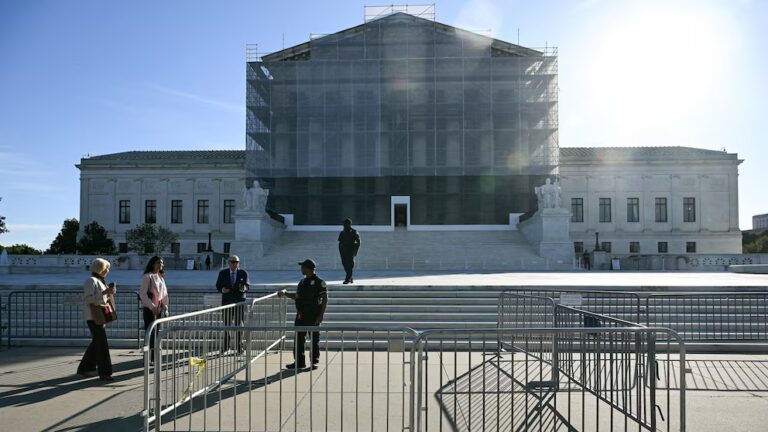
Before thousands of people took to the streets demanding the abolition of police, “abolish ICE” was the rallying cry of activists protesting the Trump administration’s immigration policies.
Democrats on the debate stage were asked about the movement to abolish the agency, also known as US Immigration and Customs Enforcement. Two candidates made dismantling the agency part of their platform, and those who did not still embraced calls for more aggressive reform. The movement pushed ideas about abolition further into the mainstream, changing the conversation around criminal justice reform.
Activists for police abolition see the two movements as intertwined, and say it isn’t a coincidence that both have risen to prominence in recent years.
“The activist communities that are involved in engaging people with the idea that we should defund the police or abolish the police or abolish ICE have a lot of cross-fertilization,” said César Cuauhtémoc García Hernández, a law professor at the University of Denver. “These are activists who often are people of color in communities where law enforcement agents of various types have a deleterious effect on them and the people around them. For lots of people who have been doing this work for many years, they view the police and ICE as working hand in hand.”
Movements to abolish ICE and the police have amassed significant support. By August 2018, about a quarter of Democrats supported calls to dismantle the agency, and more than half had come to view the agency negatively. Similarly, polls conducted in the wake of recent protests have shown an almost 15 percent increase in support for cuts to law enforcement funding.
It would be wrong to say that the movements’ messaging has had no impact, García Hernández said. “The notion of abolishing ICE has become one worthy of consideration by a much broader segment of society,” he said. “There has been an enormous shift.”
Advocates see abolishing police and abolishing ICE as part of the same movement
Many of the organizations and movements calling for the abolition of ICE are the same ones that have been working to abolish the police; they see both moves as part of their objective to dismantle repressive law enforcement.
By these activists’ definition, ICE, which has more than 20,000 agents nationwide, operates as a police force that targets and criminalizes non-white communities.
“I don’t differentiate between abolishing the police and abolishing ICE,” said Monica Mohapatra, one of the authors of “#8toAbolition,” a platform for police abolition. She listed ICE, along with sheriffs, highway patrol, campus police, school safety guards, corrections officers, and military officers, as among the forms of law enforcement that her group views as toxic.
The calls to abolish the police are informed by the work of migrant rights organizers who have opposed detention and family separations and sought to frame calls to “secure the border” as a product of American imperialism, Mohapatra added.
Police have long worked in cooperation with ICE to arrest immigrants, leading to their detention and possible deportation. During recent Black Lives Matter protests in Phoenix and New York City, ICE agents worked alongside police to take protesters into custody, even though that’s prohibited under the agency’s guidelines.
ICE can send a written request to a local jail or other law enforcement entity asking officers to continue to detain immigrants for an additional 48 hours beyond when they would otherwise be released so that the agency can take them into custody and begin deportation proceedings. ICE doesn’t need court approval to issue these requests — it can do so even if an immigrant isn’t facing any pending charges, and without probable cause that they have committed any violation.
ICE has access to a number of federal databases that help it identify immigrants to deport, including those of the Department of Motor Vehicles and the National Crime Information Center. But police can also informally share information with ICE to notify them of someone in their custody whom they suspect may have committed an immigration violation.
For many unauthorized immigrants, coming into contact with police for an offense as minor as a traffic violation could result in their deportation. Advocates have therefore understood the importance of police reform at the local level.
This cooperation between the two agencies is why some states and cities have adopted “sanctuary” policies barring local law enforcement from complying with detention requests or sharing information. The Supreme Court recently left in place a California law that prevented most state and local law enforcement officials from providing detainees’ release dates or home addresses to ICE unless it’s already public information. That law also barred immigrants who have not been convicted of a crime from being transferred to immigration custody absent a court order, with some exceptions.
But those sanctuary policies can’t entirely shield immigrants from ICE’s reaches, and other states have taken the opposite tack, encouraging cooperation between police and ICE, such as with Arizona’s SB 1070. That controversial law was largely struck down by the Supreme Court in 2012, but one provision that still stands requires immigration status checks during law enforcement stops, arrests, and detention.
“Immigrant rights activists have been very clear about engaging local elected officials for many years on policing reforms,” García Hernández said. “[Being stopped] in the street because of a traffic violation or because of some suspicion of criminal activity becomes the key moment that then sets the tone for whether or not this individual ends up in ICE’s hands and potentially getting deported.”
The movements to abolish the police and to abolish ICE often work in tandem. Some activists work on both causes, and others see their work as ideologically sympathetic.
ICE and the police are “built on the same foundation of racism and white supremacy,” said Silky Shah, executive director of Detention Watch Network, one of the first organizations to call for abolishing immigration detention.
“For police, it was to patrol and ‘catch’ enslaved people and protect white property and corporations. For ICE as an agency, it was an isolationist and Islamophobic response to the September 11th attacks,” she said. “The call to abolish ICE is a call to shift away from a system that targets, abuses, and exiles immigrants to one that values migration and human life.”
Abolish ICE shifted the Overton window — but the movement’s goals are broader
Abolitionist ideas can be traced back to at least the 1960s and ’70s, when activists focused on mass incarceration. At the time, abolishing prisons felt “almost inevitable,” as Joshua Dubler and Vincent Lloyd wrote in the Guardian in 2018. Even a commission created by the Nixon administration, which later went on to espouse a “tough on crime” stance, proposed the closure of all juvenile prisons and acknowledged “overwhelming evidence that these institutions create crime rather than prevent it.”
But the ensuing decades brought crackdowns on both crime and immigration. The US experienced a crime wave that peaked in the early 1990s, with violent crimes jumping almost fourfold during that period. The federal government reacted by increasing prison sentences, making it harder to challenge wrongful convictions, enabling police searches and seizures, and enacting strict criminal codes.
As crime dropped in the ’90s, the federal government turned its attention to immigration. In 1996, the Clinton administration backed what is now recognized as one of the most punitive immigration laws on the books, the Illegal Immigration Reform and Immigrant Responsibility Act. The law, which was touted as centrist at the time, is largely responsible for the federal government’s massive detention and deportation engine as it exists today. It laid the groundwork for ICE’s creation in 2003 as a response to 9/11.
Immigrant advocates have opposed ICE since its inception, arguing that it has criminalized and unjustly targeted communities of color. But the agency didn’t attract widespread scrutiny until Donald Trump came into office and started using the agency to enforce his hardline immigration policies, especially the separation of immigrant families that began in 2018.
“The view of the agency as something that was purely malignant really happened after Trump was elected and ramped up interior enforcement in a way that was tied pretty explicitly to the creation of a white ethnostate,” said Sean McElwee, the co-founder of nonprofit think tank Data for Progress who is credited with coining the #AbolishICE hashtag.
The abolish ICE movement drew from that of abolishing prisons in developing strategies to “defund, shame, and create popular dissent around deportation,” Mohapatra said. Leading progressives, most notably Rep. Alexandria Ocasio-Cortez, popularized the idea of abolishing the agency, bucking the prevailing view of mainstream Democrats at the time who called for keeping the agency intact while reforming it.
Over half of voters in 2018 said they didn’t support dismantling ICE, and center-left commentators warned that endorsing the movement would cost Democrats congressional seats in the midterms. But that never came to pass. Instead, the idea became a rallying cry for protesters and eventually worked its way into presidential candidates’ platforms. Sen. Bernie Sanders and New York City Mayor Bill de Blasio proposed breaking up ICE and redistributing its functions to other agencies.
More moderate candidates, meanwhile, positioned themselves against outright abolition while still embracing more aggressive reforms than Democrats had in the past. Former Vice President Joe Biden, the presumptive Democratic nominee, said he would keep the agency intact but introduce reforms to improve accountability for ICE officials and limit its ability to target unauthorized immigrants who have not committed any crimes. California Sen. Kamala Harris, who is reportedly on the shortlist to be Biden’s running mate, was careful to distinguish between her proposal to “complete[ly] overhaul” ICE and the calls to abolish it entirely.
Centrist Democrats’ efforts to distance themselves from the abolish ICE movement, however, have had their advantages: The movement was able to evolve outside the realm of electoral politics and without the baggage of the Democratic brand, McElwee said.
“The fact that politicians won’t even come close to touching it has given a lot of freedom,” he said. “If Biden embraced it, it would become much more polarized and partisan, whereas as it is now, it’s sort of a vision for a different society. That allows you to change people’s hearts and minds.”
Advocates of abolition say their goal isn’t just to shift the Overton window, the range of ideas that the public is willing to consider. They urge people to take them at their word when they say they want to dismantle the police and ICE.
When Detention Watch Network started advocating for abolishing detention in 2012, the idea was not the norm for the criminal justice reform movement, Shah said. But over time, the advocacy community began to embrace the idea of abolition rather than reforming a system that they believe harms and punishes immigrants, especially since it was an idea that originated in the communities most impacted by oppressive law enforcement.
“To actualize our vision, to move us forward, we have to talk about the world we want to see,” Shah said. “Today we have people talking about the issues in ways that seemed far-fetched just a few weeks ago. There is a lot of self-education happening, a lot of conversations, and a lot of action. I don’t think we can discount the role of powerful slogans in that respect.”
Support Vox’s explanatory journalism
Every day at Vox, we aim to answer your most important questions and provide you, and our audience around the world, with information that has the power to save lives. Our mission has never been more vital than it is in this moment: to empower you through understanding. Vox’s work is reaching more people than ever, but our distinctive brand of explanatory journalism takes resources — particularly during a pandemic and an economic downturn. Your financial contribution will not constitute a donation, but it will enable our staff to continue to offer free articles, videos, and podcasts at the quality and volume that this moment requires. Please consider making a contribution to Vox today.
Sourse: vox.com





